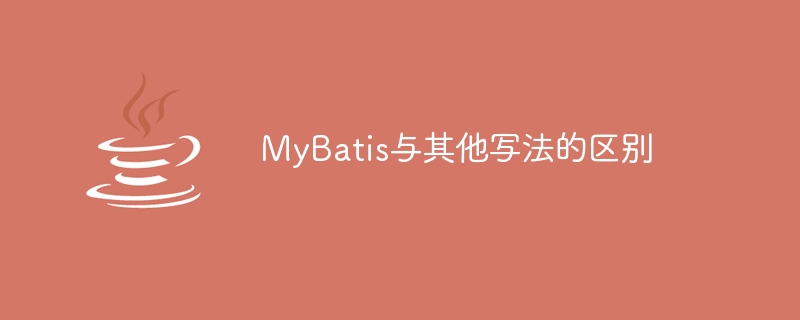区别在于MyBatis与其他方法的不同
- WBOYWBOYWBOYWBOYWBOYWBOYWBOYWBOYWBOYWBOYWBOYWBOYWB原创
- 2024-02-19 12:58:201215浏览

区别在于MyBatis与其他方法的不同,需要具体代码示例
随着Java开发的不断演进,越来越多的ORM(对象关系映射)框架出现在开发者的视野中。其中,MyBatis作为一款经典的ORM框架,备受广大开发者的喜爱。与其他写法相比,MyBatis具有一些显着的区别,下面将通过具体的代码示例来阐述这些区别。
- 持久层代码与SQL的解耦
传统的JDBC编程中,我们需要在代码中编写大量的SQL语句,直接与数据库交互。而MyBatis通过配置XML映射文件,将SQL语句与Java代码进行解耦,使得我们只需要关注业务逻辑,而不必关心具体的SQL语句。示例如下:
// 使用MyBatis之前
public User getUserById(int id) {
Connection connection = getConnection();
String sql = "SELECT * FROM user WHERE id = ?";
PreparedStatement preparedStatement = connection.prepareStatement(sql);
preparedStatement.setInt(1, id);
ResultSet resultSet = preparedStatement.executeQuery();
// 处理结果集
// ...
}
// 使用MyBatis之后
public User getUserById(int id) {
return sqlSession.selectOne("UserMapper.getUserById", id);
}通过上述代码示例,我们可以清楚地看到,在使用MyBatis之后,我们只需调用sqlSession的方法,将具体的SQL语句的执行过程交给MyBatis框架处理。 sqlSession的方法,将具体的SQL语句的执行过程交给MyBatis框架处理。
- 参数传递的灵活性
在传统的JDBC编程中,我们需要通过问号占位符的形式传递参数,非常繁琐。而MyBatis允许我们通过#{}标记来传递参数,同时还支持各种复杂类型的参数传递。示例如下:
// 使用MyBatis之前
public List<User> getUsersByCondition(String name, int age) {
Connection connection = getConnection();
String sql = "SELECT * FROM user WHERE name = ? AND age = ?";
PreparedStatement preparedStatement = connection.prepareStatement(sql);
preparedStatement.setString(1, name);
preparedStatement.setInt(2, age);
ResultSet resultSet = preparedStatement.executeQuery();
// 处理结果集
// ...
}
// 使用MyBatis之后
public List<User> getUsersByCondition(@Param("name") String name, @Param("age") int age) {
Map<String, Object> paramMap = new HashMap<>();
paramMap.put("name", name);
paramMap.put("age", age);
return sqlSession.selectList("UserMapper.getUsersByCondition", paramMap);
}通过上述代码示例,我们可以看到,在使用MyBatis之后,我们可以直接通过方法参数的注解来传递参数,无需再手动设置参数的位置和类型。
- 缓存机制的支持
MyBatis内置了一套强大的缓存机制,可以大大提高数据查询的效率。在相同的查询条件下,MyBatis会先从缓存中获取数据,如果缓存中不存在,则执行SQL查询并将数据存入缓存。示例如下:
// 使用MyBatis之前
public User getUserById(int id) {
Connection connection = getConnection();
String sql = "SELECT * FROM user WHERE id = ?";
PreparedStatement preparedStatement = connection.prepareStatement(sql);
preparedStatement.setInt(1, id);
ResultSet resultSet = preparedStatement.executeQuery();
// 处理结果集
// ...
}
// 使用MyBatis之后
// 注解配置缓存
@CacheNamespace(size = 1024)
public interface UserMapper {
@Select("SELECT * FROM user WHERE id = #{id}")
@Options(useCache = true)
User getUserById(int id);
}通过上述代码示例,我们可以看到,在使用MyBatis之后,我们只需使用@CacheNamespace注解配置缓存,并在@Options注解中设置useCache = true
- 参数传递的灵活性
在传统的JDBC编程中,我们需要通过问号占位符的形式传递参数,非常繁琐。而MyBatis允许我们通过#{}标记来传递参数,同时还支持各种复杂类型的参数传递。示例如下:
- 🎜缓存机制的支持🎜MyBatis内置了一套强大的缓存机制,可以大大提高数据查询的效率。在相同的查询条件下,MyBatis会先从缓存中获取数据,如果缓存中不存在,则执行SQL查询并将数据存入缓存。示例如下:🎜🎜rrreee🎜通过上述代码示例,我们可以看到,在使用MyBatis之后,我们只需使用
@CacheNamespace注解配置缓存,并在@Options注解中设置useCache = true即可开启缓存功能。 🎜🎜总结:🎜以上是MyBatis与其他写法的一些区别和优势的具体代码示例。相比于传统的JDBC编程,MyBatis通过将SQL与Java代码解耦,提供了更加简洁和易读的代码编写方式;同时,MyBatis还支持参数传递的灵活性和内置的缓存机制,可以大大提高开发效率和系统性能。因此,在实际开发中,我们可以选择使用MyBatis作为ORM框架,来更好地组织和管理数据库操作。 🎜以上是区别在于MyBatis与其他方法的不同的详细内容。更多信息请关注PHP中文网其他相关文章!
声明:
本文内容由网友自发贡献,版权归原作者所有,本站不承担相应法律责任。如您发现有涉嫌抄袭侵权的内容,请联系admin@php.cn

